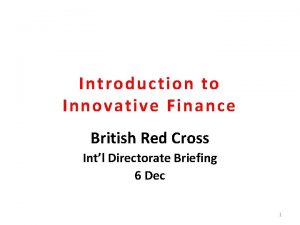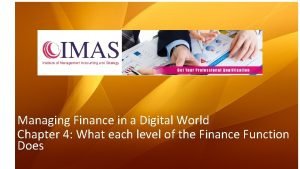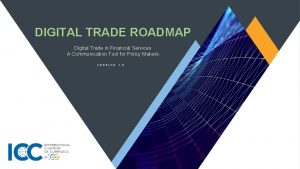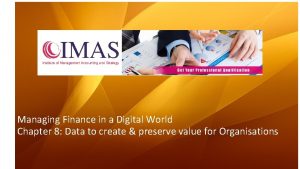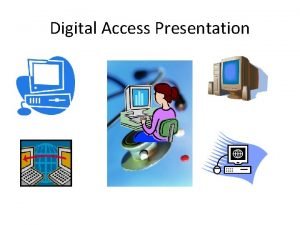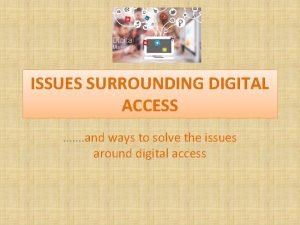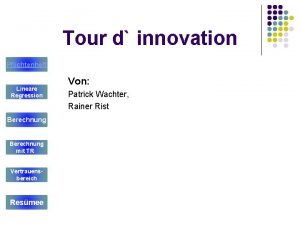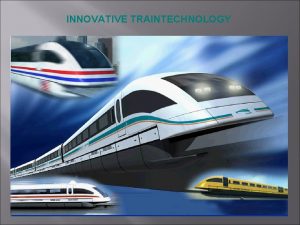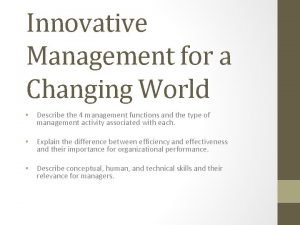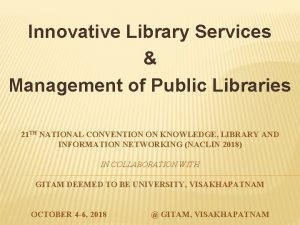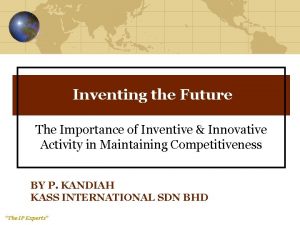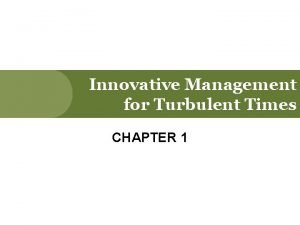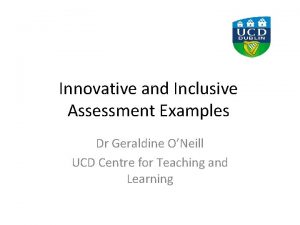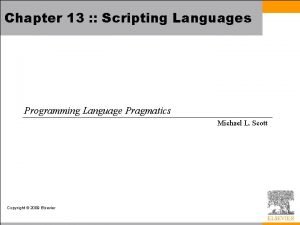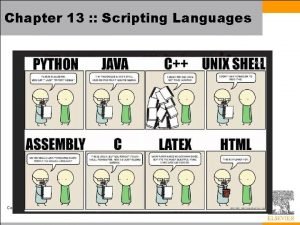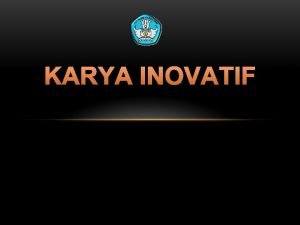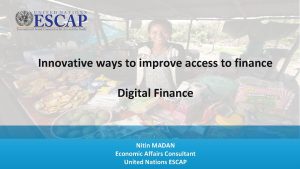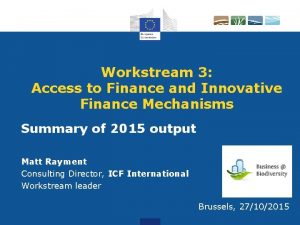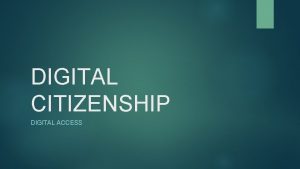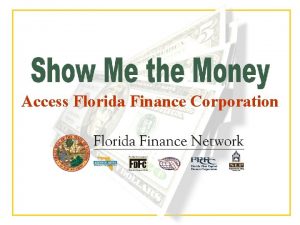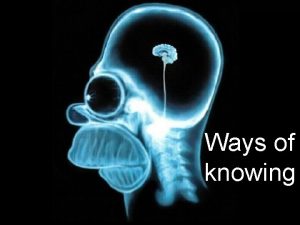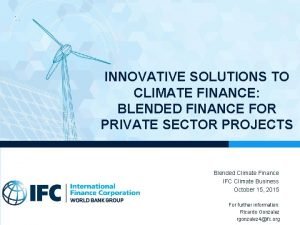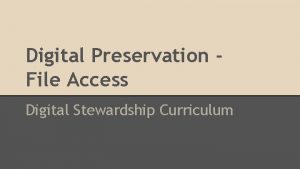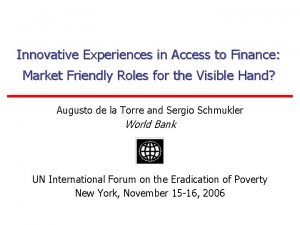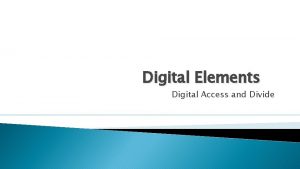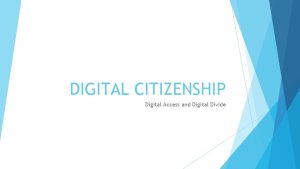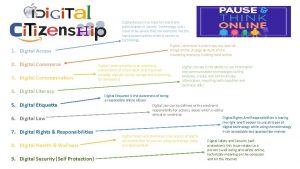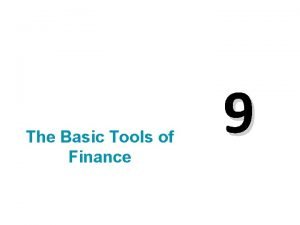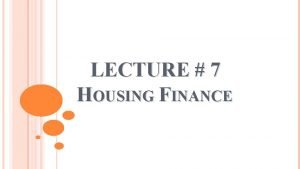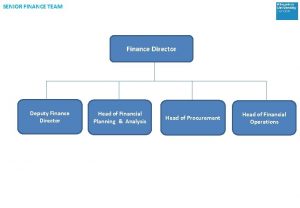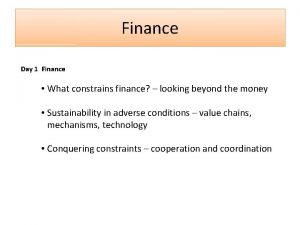Innovative ways to improve access to finance Digital

































- Slides: 33

Innovative ways to improve access to finance Digital Finance Nitin MADAN Economic Affairs Consultant United Nations ESCAP

A few definitions DIGITAL FINANCIAL INCLUSION The use and promotion of digital financial services (DFS) to advance financial inclusion DIGITAL FINANCIAL SERVICES (DFS) The broad range of financial services accessed and delivered through digital channels, including payments, credit, savings, remittances and insurance DIGITAL CHANNELS Refers to the internet, mobile phones (both smartphones and digital feature phones), ATMs, POS terminals, NFC-enabled devices, chips, electronically enabled cards, biometric devices, tablets, phablets and any other digital system FINTECH The use of technology and innovative business models in the provision of financial services Source: Alliance for Financial Inclusion


Digital financial inclusion Driven by Payment Services

Financial inclusion and DFS (% of adult population) Adults with a bank account Made or received digital payments n o i l l i b 2 1. s t l u ad d e d ad 2017 – 69% 3. 8 billion adults 2017 – 52. 3% 2014 – 61% 2014 – 41. 5% 2011 - 51% - DFS establishing roots – opportunity to accelerate financial inclusion - Most significant gains (including on gender equality) – When focused on digital payments - Digital payments – gateway to other financial products Source: Global Findex Data 2018

A Digital Financial Inclusion Pathway ? Digital in-store purchases: People conduct majority of transactions digitally (including in-store) Why leading with payments is preferred Basic connectivity: Critical mass of mobile coverage and penetration amongst rural poor Sta ge 3 Full range of DFS: People adopt and use digital for savings, credit and insurance Digital remote payments: People adopt and use digital for P 2 P and P 2 G transfers Sta ge 1 2 4 • Overcoming initial trust barriers • Strong demand for secure, fast and convenient transfers • Limited range of prudential regulations can be applied – preferred by regulators • Allows for adopting a range of providers (e. g. MNOs) Source: A Digital Pathway to Financial Inclusion, Dan Radcliffe and Rodger Voorhies (2012)

Basic regulatory enablers 01 Nonbank E-Money Issuance Licenses for non-bank DFS providers to issue e-money accounts without being subjected to the complete range or prudential norms 04 Consumer Protection Tailored consumer protection rules for all kinds of DFS providers and products 02 Use of Agents Permit banks and non-banks to use agents such as retail shops to service customers 03 Risk Based Customer Due Diligence Proportionate anti-money laundering framework that require simplified CDD for lower-risk accounts and transactions Source: Basic Regulatory Enablers for Digital Financial Services, Stefan Staschen & Patrick Meagher (CGAP), 2018

A boarder enabling ecosystem is critical E. g. : How to use digital tools for purposes such as accounting and storing/generating invoices Financial Education E. g. : Consumer Appropriate products Protection Transparent pricing Grievance redressal mechanism

Spotlight on Regulators Regulation and regulators will be crucial in the context of DFS ‘The regulatory perimeter needs to be reviewed and perhaps redefined, new providers licensed and supervised, cyber-security standards improved, consumer protections New business models made more robust, and data protection and privacy and New risks competition laws strengthened, among others. There is a growing need to better equip regulators to deal with the challenges ahead, and this is an area that is often overlooked by the development community. ’ Great Expectations: Fintech and the Poor Greta Bull, 2019

MSMEs and DFS FIs reluctance to lend Big Data and AI Lack of financial and/or credit history inadequate or inappropriate collateral Helping FIs better understand credit risks and repayment frequencies 1 2 Digital alternative An alternate route possibility of accumulating data points (including alternative data) 3 4 ‘Accumulated digital data can complement the limited data disclosed by SMEs and reduce the cost of information asymmetries’ Fintech for Asian SMEs (Nemoto & Yoshino, 2019)

MSMEs - DFS - access to non-credit services Mobile Wallets Savings account Payments and transfer options Payments/transfers Digital footprint Cash-flow based lending possibilities Accounting software Generates financial statements Invoice financing possibilities

Financial inclusion landscape in target countries

Financial inclusion in the target countries (% adult) Country 2014 - 2017 BANGLADESH Male Female BHUTAN# Male Female CAMBODIA Male Female LAO PDR Male Female NEPAL Male Female Account& 31 – 50 35 – 65 26 – 36 34 39 28 22 – 22 24 – 22 20 – 22 27 - 29 27 – 26 26 – 32 34 – 45 37 – 50 21 - 42 Source: Global Findex Database, 2018 Financial Institution$ Mobile Money a/c Made/received digital payment 29 - 41 33 – 50 25 - 32 34 39 28 13 - 18 15 – 18 11 – 17 27 - 29 27 – 29 26 – 32 34 – 45 37 – 50 31 - 42 3 - 21 3 – 32 2 - 10 NA NA NA 13 - 16 14 - 6 13 - 5 NA NA NA 7 - 34 10 – 47 4 - 21 17 21 12 18 - 16 19 – 16 16 - 15 13 12 15 9 – 16 12 – 20 7 - 13 Borrowed Saved (FI) Borrowing for (FI) business/farm ^ 10 – 9* 10 – 10 10 - 8 4 4 4 28 - 27 25 - 23 29 - 30 18 - 9 19 - 10 17 - 8 12 – 13 15 – 13 10 - 14 7 - 10 8 – 10 7 - 10 23 24 21 4 -5 5 -6 3 -5 19 - 18 20 - 17 19 - 19 16 – 17 19 – 16 14 - 18 4 – 10 6 – 12 2 -8 3 4 2 15 - 16 15 – 16 6 8 4 8 - 14 10 – 15 7 - 13

Financial inclusion in Cambodia Remittances Transactions 3% 35% 9% 3%3% 1% 56% 89% 1% Insurance 95% 4% Savings 7% 4% Credit 6% 2% 7% Banked 21% 12% 56% 7% 58% Other Formal (non-bank) Source: Cambodia Financial Inclusion Roadmap 2017 / Finscope Informal Family & Friends Excluded

Source: SME Finance Forum (2019) Formal MSME access to finance US$ 3. 7 billion US$ 2. 6 billion 87% US$ 3. 6 billion 86% 83% US$ 39 billion 67% US$ 0. 91 billion 32% Micro 7% SME 93% Micro 10% SME 90% Micro 40% SME 60% Micro 55% SME 45% Micro 21% SME 79% Bangladesh Bhutan Cambodia Lao PDR Nepal

Source: SME Finance Forum (2019) Formal MSME access to finance: Gender gap M F Enterprise ownership M F Share of finance gap 95 Women-owned MSMEs with credit constraints (% of total WMSMEs) 94% % 81% 62% 48% 68% 54% 82% BANGLADESH 58% 91% 6% 5% 61% BHUTAN 19% 6% 38% 17% 38% CAMBODIA 32% 6% 52% 31% 46% 39% 18% 66% 42% 6% LAO PDR NEPAL 9%

Exploring supply, demand reasons for constraints

Supply side Country Bangladesh Banks % MFIs Payment Service Providers RCO/VFs Capital Markets/V C 70 Bhutan 89% Cambodia 84% Lao PDR 96% Nepal 93% Others include – Pawn shops, leasing, insurance companies, cooperatives

Demand side Ease of Doing Business Indicator Ease of doing business (overall) Getting credit Enforcing contracts Resolving insolvency Source: Ease of Doing Business (2020) Bangladesh 168 119 189 154 2020 Rank (out of 190) Bhutan Cambodia Lao PDR 89 144 154 94 25 80 29 182 161 168 82 168 Entrepreneurship • Cultural issues – enterpreneurship is not viewed as a career option. Failure is viewed negatively • Risk acceptance and institutional support • But this is CHANGING • Governments are increasingly adopting policies to encourage enterpreneurship Nepal 110 99 154 83

Common constraints in MSME access to finance Constraining Factors AWARENESS Supply Side • Lack information about products and services offered by formal FIs • Lack of awareness of FI processes RISK • High degree of informality restricts access • Absence of collateral or lack of adequate collateral • High reliance on collateral-based lending • Immovable assets not accepted as collateral KNOWLEDGE • Low levels of financial literacy accounting, business planning • Lack of staff skill to conduct cash-flow based assessments • Inadequate loan sizes limit growth • Informal lender offer better suited products • Short loan terms • Market segmentation - by loan size, not by client characteristics • Same credit appraisal tool applied across all types of enterprises PRODUCT & PROCESS Sources: Multiple Demand Side

Constraining factors particular to target country Bangladesh Bureaucratic nature - Hinders innovation and risk taking - Products repackaged Perception - Higher value attached to large brands/companies Sources: Multiple Lao PDR Interest Rate - Charged on a flat basis Community - Social solidarity networks are important in managing risks Nepal Interest Rate - Variable rates – revised upwards

Constraints faced by WMSMEs Similar Challenges as male counterparts Challenges may be more severe these are often entrenched in gender stereotypes, limited education opportunities, and restricted mobility Cultural and social norms - Perception - women cannot manage businesses or have the necessary leadership skills for business. These may restrict business hours, dealing with male suppliers/customers, government officials - Dual role - businesswomen and homemakers restricts mobility leading to poor access to networks, trainings, often prevents expansion of the business Sources: Multiple

DFS and A 2 F

Infrastructure Country Indicator 4 G 3 G 2 G (% population) Mobile Connections Mobile Ownership (% penetration) (unique subscriber) Bangladesh 17 94. 2 95. 5 93 52. 6 Bhutan 55 88 98 107 53. 5 Cambodia 93 90 99 153 67. 2 Lao PDR 9 83. 7 98 81 65. 5 32. 1 72. 7 92. 5 134 53. 6 Nepal Sources: GSMA Mobile Connectivity Index (2018)

Growing agent network Bangladesh No. of agents No. of registered clients (million) No. of active accounts in (million) No. of total transaction No. of daily average transaction Product wise information Inward Remittance Cash In transaction Cash Out Transaction P 2 P transaction Salary Disbursement (B 2 P) Utility Bill Payment (P 2 B) Merchant Payment Government Payment Aug-15 Aug-19 533, 898 951, 115 2. 82 7. 35 0. 95 3. 30 102, 073, 061 204, 220, 475 3, 402, 435 6, 587, 757 Amount (in crore BDT) 2. 54 34. 37 5, 399. 36 12, 524. 16 4, 689. 25 12, 346. 07 2, 246. 05 8, 196. 47 119. 00 903. 27 117. 64 487. 82 407. 23 9. 42 Sources: Annual Reports of Central Banks and Supervision Reports of Central Banks Bhutan 2013 2017 Adult population 474, 334 494. 586 Commercial bank 4. 3 3. 01 branches/10, 000 adults Total branches 203 149 ATMs/10, 000 adults 3. 94 3. 8 Total ATMs 187 188 Agents/10, 000 adults 43 Total Agents 2, 133 Po. S/10, 000 adults 15. 35 Total Po. S machines 759 Bank Agents/10, 000 adults 8. 23 Total Bank Agents 407 Primary services: P 2 P, G 2 P, and P 2 G payments

…Growing agent network Cambodia Internet banking transactions Value of internet banking transactions Mobile banking services transactions Bank and NBFI payment transactions value Bank and NBFI payment agents PSP Agents PSP transactions Payment transaction value Dec 2017 Dec 2018 1, 032, 674 US$ 5. 1 billion 14, 074, 983 92, 924, 651 23, 022 US$ 16 billion 10, 285 24, 164 51, 800, 296 US$ 7 billion Sources: Annual Reports of Central Banks and Supervision Reports of Central Banks Lao PDR - Pilot 2014 to 2017 – 0 to 446 agents Services Phase 1 (2014 – 2017): OTC, cash remittances, cash to own (deposits) and cash to others (payments/transfers) Phase 2 (2017 onwards): Interbank transfers, cash withdrawals, opening on the spot basic bank accounts with an ATM card, and payment of road tax (P 2 G)

Nepal dashboard Nepal Mid-July 2017 Number of Branchless Banking center 2018 1, 008 1, 248 2, 438, 222 4, 711, 097 766, 958 810, 674 1, 874 2, 252 Number of Debit card holders 4, 694, 066 5, 307, 970 Number of credit card holders 68, 966 104, 721 101, 458 96, 816 Number of mobile banking customer Number of Internet customer Total no of ATM Number of prepaid card holders Mobile banking services: - Balance inquiry and mini statement - Last transaction information - Withdrawal alerts - Cheque book inquiry/request - Inter-bank and intra-bank fund transfer - Utility bill payments Population covered by access points Branch – 2, 882 ATM – 7, 812 BLB – 17, 668 Registered Agents July 2019 149, 000 Activity rate 40% - 50% Sources: Annual Reports of Central Banks, Supervision Reports of Central Banks, Central Bank Reports on Payments Activity rate – rural 60% - 70%

Basic regulatory enablers 01 Nonbank E-Money Issuance • Payment Service Provider Regulation are in place • Non-bank e-money allowed (except Bangladesh) 02 Use of Agents • Significant increase in agent numbers 04 Consumer Protection • Target countries need specific DFS related consumer practiced rules 03 Risk Based Customer Due Diligence • Practiced. E. g. in case of higher value transactions, additional KYC needed

Creating and enabling environment ‘Digital Bangladesh’ • Regulation on Payment Service Providers (2014), Mobile Financial Services and the agent banking models (2018) • Fostering innovation via the Digital Financial Services Lab • Scaling up the National ID effort (Smart. National Identity) Agent banking (2016), E-money issuer (2017), and Payment and Settlement Systems (2018) A payment gateway - to enable interoperability, internet banking, P 2 P, G 2 P, and P 2 G payments Bank of Bhutan e-wallet app - CHHARO - for online purchase of goods and services (2018) Digitised the G 2 P and G 2 G payments (2019) Payment system to allow for real time fund transfer and to multiple accounts (2019) ‘Towards cashless and digital society’ in Bhutan • • • ‘The match has been lit’ in Cambodia • National clearing system (2012), Fast Payment System (2016), Cambodia Shared Switch (2017), • PSP Regulation (2017) – licenses for payments, e-wallets and use of non-bank agents • Bakong (2019) – blockchain for cross platform transfers, augments interoperability

Creating and enabling environment ‘Dawn of digital finance’ in Lao PDR Digital finance ‘on top of the world’ - Nepal • • Began in 2014 – Enacted Payment Systems Law (2018) - Mobile money and agents driven Financial Inclusion Roadmap prioritises - payments infrastructure The four core areas of intervention under this • Strengthening the regulatory framework • Improvements to the payment infrastructure • Pilots on mobile money • Strengthening agent networks, and increased interoperability • Mobile money and agents driven • Payment Settlement Bylaws (2015) • National Payment System Development Strategy (2014)

Wing + Banhji collaboration: Using alternative data • Wing providing free of charge access to Bhanji’s • Improving SMEs’ real-time visibility & insight into their financial position and performance Specialized Bank (Payments + Transfers) • Data driven credit decision Alternative credit decision (Online accounting software) Sources: Sim Chankiriroth, Report on Financial Technology (Fin. Tech) in Cambodia (2017); Khmer Times, Wing as corporate solution provider (2019)

Which stage of digital financial inclusion are you in ? Digital in-store purchases: People conduct majority of transactions digitally (including in-store) Full range of DFS: People adopt and use digital for savings, credit and insurance Digital remote payments: People adopt and use digital for P 2 P and P 2 G transfers Basic connectivity: Critical mass of mobile coverage and penetration amongst rural poor Sta ge 4 Sta ge 3 Sta ge 2 Sta ge 1

Thank you Nitin MADAN madannitin 78@gmail. com +855 92 917 385
 Adam bornstein red cross
Adam bornstein red cross Difference between spirituality and religion
Difference between spirituality and religion Restore and improve urban infrastructure
Restore and improve urban infrastructure Gods ways are not our ways
Gods ways are not our ways Terminal access controller access control system plus
Terminal access controller access control system plus Terminal access controller access-control system
Terminal access controller access-control system Finance in a digital world
Finance in a digital world Car finance digital marketing
Car finance digital marketing Digital trade
Digital trade Finance in a digital world
Finance in a digital world B connect jr
B connect jr Bcps digital content
Bcps digital content Internet access survey questions
Internet access survey questions Provider digital access
Provider digital access Digital access issues
Digital access issues Innovative teaching methods in english
Innovative teaching methods in english These are entrepreneurs who are to follow the path
These are entrepreneurs who are to follow the path Planzeittabelle
Planzeittabelle Innovative train technology
Innovative train technology Innovative management for a changing world
Innovative management for a changing world Innovative library services
Innovative library services Innovative healthcare business solutions
Innovative healthcare business solutions Innovative business communication
Innovative business communication Functional vs innovative products examples
Functional vs innovative products examples 9 color wheel
9 color wheel Microsoft teacher academy
Microsoft teacher academy Inventive and innovative
Inventive and innovative Innovative management for turbulent times
Innovative management for turbulent times Inclusive assessment examples
Inclusive assessment examples Innovative analytical solutions
Innovative analytical solutions Explain the innovative features of scripting languages.
Explain the innovative features of scripting languages. Innovative features of scripting languages
Innovative features of scripting languages Contoh karya seni kompleks
Contoh karya seni kompleks Organizational innovation definition
Organizational innovation definition
